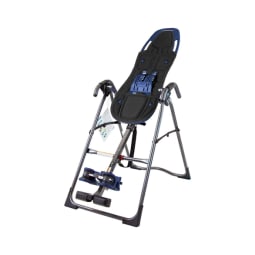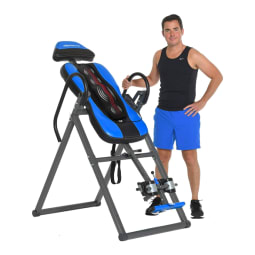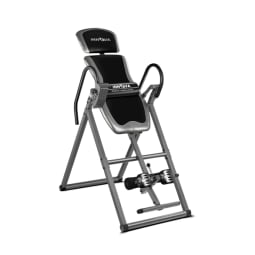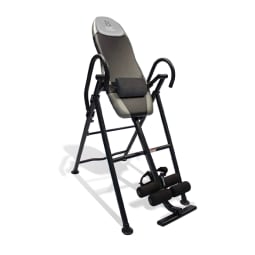While more traditional methods like yoga ropes and headstands will still help you achieve the benefits of inversion, inversion tables allow users to safely tilt backward at varying angles, in order to stretch, decompress, and take pressure off the spine. If you’re suffering from a sore back, swollen legs, or general muscle soreness, this might be just the tool you’re missing. Keep reading to learn how inversion tables can benefit your physical recovery and overall health and to find our picks for the best inversion tables of 2023. Sherry McLaughlin, MSPT, physical therapist and founder of the Michigan Institute for Human Performance, explains, “The teeter design allows one to control the amount of traction applied and even oscillate the traction to allow for compression and decompression that facilitates disc nutrition.” Although inversion tables are often used by physical therapists and chiropractors, they’ve now become more accessible with plenty of at-home options. According to McLaughlin, “Those with sciatica, herniated lumbar discs, or general back pain from prolonged flexion positions such as sitting, bending forward or digging may benefit from using an inversion table.” Even people with no existing back pain may find these tables to be a relaxing way to decompress. That said, inversion tables aren’t for everyone. “There are some back injuries that may be aggravated with an inversion table,” McLaughlin warns. “People who have increased pain with walking or standing may not feel relief with this intervention, and it may even increase their symptoms.” “Individuals with spinal stenosis or back pain stemming from a hip flexor spasm may not tolerate inversion tables as they don’t usually tolerate extension positions of the spine,” she adds. It’s also generally recommended that pregnant women, and those with high blood pressure or a history of heart disease or stroke, don’t use inversion tables. Not sure if you fit into one of these categories? It’s always best to check with your health care provider before trying something new like this. “If inversion therapy is working, pain should diminish immediately,” she explains. “It may take a few sessions to see long-term changes, but short-term decrease in pain is a sign that it is a good therapy to be used. If there is no change in symptoms immediately with inversion therapy, then long-term benefit will probably not be seen.” The table comes with eight adjustable, removable acupressure nodes for trigger-point relief and a lumbar bridge with an adjustable arch that allows for deeper lower-back traction. For $20 more you can add a detachable, padded cushion to the table’s ComforTrak bed—which we strongly suggest you do, as it will make all the difference in the comfort of your table. There are hand grips at the top of the frame (or bottom, depending on your position) that allow for further stretching and decompression, and you can use the tether system to set the table at 15, 30, or 60 degrees, or choose to customize the angle. With the table’s precision balancing system, you’re able to lock it into place while in your full inversion and then use the controlled rotation to return to an upright position. What our editor says: “Trust the experts when they say you’ll feel the benefits of a good inversion table right away. I’ve used this one a number of times in a PT’s office, and I absolutely noticed an impact. I was hesitant to get upside down at first, but the locks do feel very secure. While in the chair, I feel a juicy stretching sensation, and immediate relief in my lower back specifically. Plus, the acupressure nodes are an added bonus. I’d use this daily if I had one at home.” —Carleigh Ferrante, commerce editor The ankle grips have a wrap-around design that helps you feel safe and secure, and they’re lined in a comfortable foam. What sets this chair apart most is the longer ankle lock handle, which can be controlled by the push of a button. The lever makes it easy to lock and unlock, without needing to bend over and reach. There’s also a secondary gravity-activated lock that will set into place as you rotate into your inversion, as a precautionary safety measure. Like the EP-560, this bed allows you to lock out in full inversion and use controlled rotation to return to an upright position but adds on an eight-point floating suspension system that lifts the bed off the frame for additional flexion. It uses a pre-marked tether system instead of a lock and pin, so you can set the table at a 15-, 30-, or 60-degree angle or customize to the degree you prefer. Not sure where to begin? Download the brand’s free app and you’ll have access to a ton of tutorials, how-to videos, and guided inversion sessions. What Customers Say: If you’ve struggled with ankle supports in the past, the triple safety ankle locking system will give you peace of mind. It uses a primary lock, twist lock, and automatic safety lock for added security. There are also extended hand grips and a tether system to adjust the table angles. What Customers Say: A six-angle pin system lets you adjust the table’s angle into six different positions without dismounting from it. There’s also a reversible ankle-holding system with foam rollers and U-shaped holders that can be switched to the front or the back, depending on user preference. What Customers Say: Although the table can be folded, a few people say it’s bulky to store—and some reviewers do complain about difficulties with assembly. If this is a concern for you, we recommend buying it assembled for an additional fee. It has a height selector rod and a rear adjustment bar that make it easy to select the angle you want. Choose from a 20-, 40-, 60-, or 90-degree rotation, and use the ankle locks to secure yourself into place. While a lot of foldable inversion tables are flimsy, this one feels sturdy and durable. What Customers Say: Everything about the table is sturdy. It has quadruple protection precautions, so you can feel safe and at ease while you’re using it. The four-position inversion lock is located on the side of the handlebars and is incredibly easy to reach. The ankle supports can also be locked into place via a long lever. Like many other tables, this one can be positioned at a 20-, 40-, 60-, or 90-degree inversion position. What Customers Say: There are four different inversion angles (20, 40, 60, and 90 degrees), which are selected using a lock and pin. As an added bonus, there’s an adjustable vibration and heat therapeutic massage lumbar support pad. Reviewers also like that it’s easy to assemble. What Customers Say: There are a ton of great reviews for this inversion table, and it has a 4.6 rating overall. One person notes, “My wife loves the comfort of the ankle/heel closure. We both like the preset position pin options, and all the adjustments for height, angle of inversion, and ankle clamp are easy and secure. We can recommend this machine.” When choosing a table, you should also think about your individual needs and which features will make for a more comfortable and enjoyable experience. Features like a longer lock bar or handles on the sides are not necessarily essential, but they’re important to people who want added support or don’t want to be constantly reaching and bending to adjust. Consider whether you want a table with some extra bells and whistles. “Some units, like Teeter’s, boast adjustable nubs for trigger point pressure of the back, as well as an attachment to improve lumbar extension,” says McLaughlin. Other tables offer heat, massage features, and/or coaching apps. If you’ve never used an inversion table before, you might want to look at a table’s “try it before you buy” policy, which most inversion tables come with. As McLaughlin says, you should find immediate short-term results—and you might want something you can return if you don’t.









